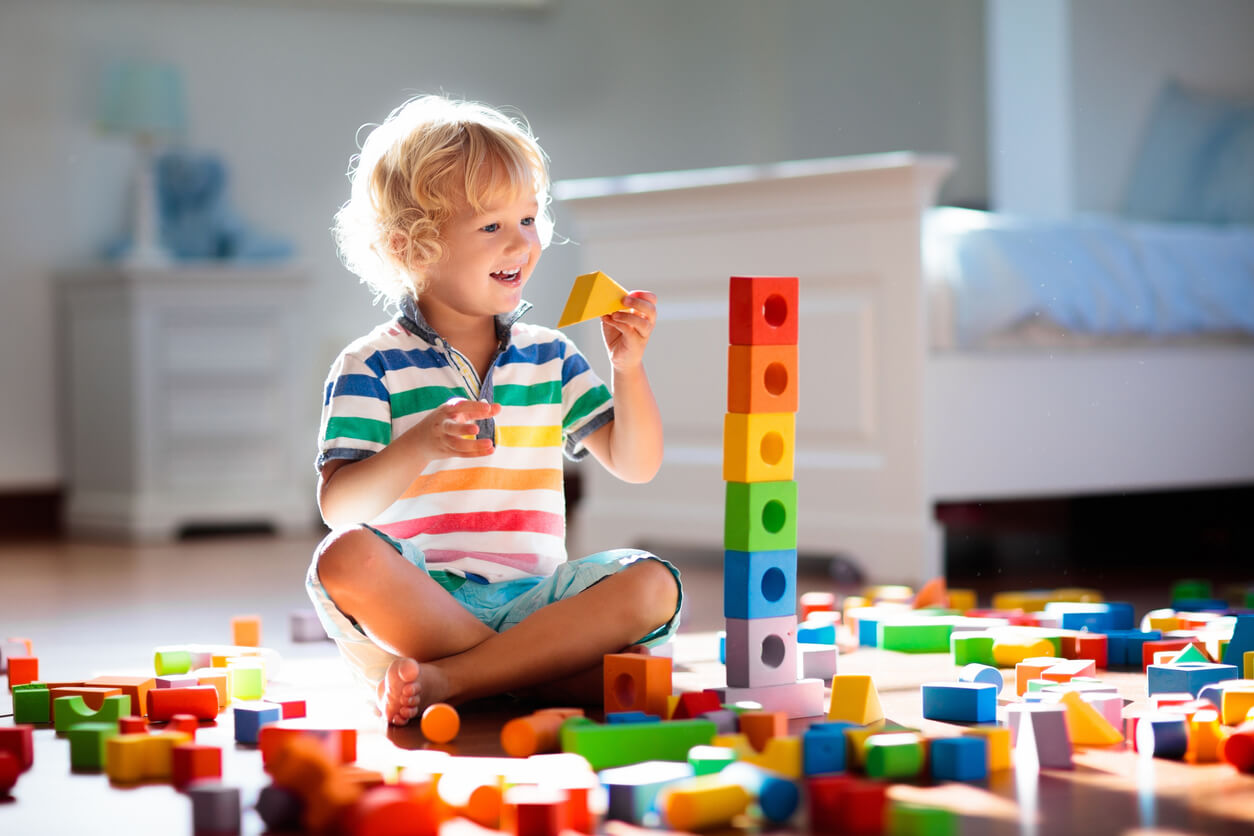Children Sharing a Room: 5 Tips to Improve their Autonomy


Written and verified by the psychologist Sharon Capeluto
If your children share a room, it’s important to promote their autonomy. Sometimes, they have no choice but to sleep next to their siblings, which can be a great experience, of course! However, sharing a room can be detrimental to the development of each child’s autonomy if certain measures aren’t taken.
In this article, we’ll share with you five practical recommendations to enhance the independence of your children who share a room.
Why is independence so important?

Independence is the ability to make decisions autonomously without having to depend on other people. It’s an essential aspect of personal development, growth, and self-fulfillment. In turn, it contributes to a sense of freedom and self-confidence.
It’s clear that having siblings implies sharing. It’s a fraternal bond in which union, companionship, and understanding prevail. However, it’s important to encourage independence in each of our children, thus avoiding a dependent relationship between siblings.
Read also: Dependent Relationships Between Siblings
How to encourage autonomy in children who share a room?
To ensure a good coexistence when sharing a room, it’s essential to consider each other’s needs, have personal spaces, and clearly identify what’s private and what isn’t.
Consider these tips to help your children care for and build their independence, even when sharing a room with their siblings.
1. Individual Storage Spaces
One of the first steps to consider in fostering independence in children who share a room is to ensure individual spaces. So, in addition to designating each child their own space in the closet, you can set aside separate drawers and shelves for each child to store their belongings.
This way, they’ll be able to organize and take care of their things independently from their sibling. In parallel, this distinction helps to enhance the sense of responsibility and privacy. It’s about creating some individual spaces within the shared bedroom.
2. Shared objects and personal objects
“Your toys, my toys, our toys“. This should be the rule. It’s desirable for children to have both personal toys as well as toys or objects that they share with their siblings. Having a combination of both is beneficial to their development. Each case has different positive contributions.
- Personal toys: Give children the opportunity to have objects that reflect their particular interests and tastes.
- Shared toys: Encourage companionship, solidarity, and communication. They also help children learn to consider the wants and needs of others.
3. Specific tasks for each child
From a very young age, children can begin to cooperate with simple household chores. At two or three years of age, they can put away their toys and even pick up clothes from the floor. Later on, they can take on more complex activities such as making the bed or setting the table.
Assigning differentiated tasks to each child helps strengthen their autonomy, while they learn to contribute to a common good. For example, if two siblings ages five and eight share a room, the younger one can take care of picking up things from the floor, and the older one can vacuum or dust the furniture.
4. Personal decorating
Decorating is one of the most important aspects for children. They want their rooms to look nice, but above all, to reflect who they are. In this regard, agreeing with a sibling about the choice of colors, accessories, and even the arrangement of furniture can be a challenge.
It’s important to help them acquire negotiation and communication skills, as explained in an article published by the Universidad Autónoma del Estado de México. However, you can also offer to let each one choose some decoration elements individually.
Because who says that everything has to be the same? Giving them the possibility to select their wall stickers, lamps, or the colors of their bedspreads will give them some sense of ownership over their space and help children sharing a room promote their autonomy.
Discover: 4 Ideas to Make Wall Hangings to Decorate Your Children’s Room
Clear boundaries
When sharing a room, boundaries are often blurred. Sometimes, the atmosphere becomes uncomfortable, as children want to be free in their own bedrooms. However, this can lead them to neglect each other’s needs.
For example, turning on the TV when their sibling is doing homework or playing with Legos while the other is taking a nap.
This is why it’s essential to set clear boundaries regarding privacy and mutual respect. If the conflict persists, you can intervene and help them find a solution; such as setting schedules or having a study space in another area of the house. Ultimately, it’s about helping them understand the importance of autonomy and developing empathy.

From the superficial to the profound
Although it may seem like a superficial matter, every little change in a child’s room can have a significant impact on the development of their independence and individuality. At first glance, it may seem like just rearranging furniture or decorating bunk beds. But in truth, these modifications go far beyond that: They have profound consequences on personality.
These simple modifications help them explore their identity and take an active role in creating their own space. And what could be more important than having a choice?
If your children share a room, it’s important to promote their autonomy. Sometimes, they have no choice but to sleep next to their siblings, which can be a great experience, of course! However, sharing a room can be detrimental to the development of each child’s autonomy if certain measures aren’t taken.
In this article, we’ll share with you five practical recommendations to enhance the independence of your children who share a room.
Why is independence so important?

Independence is the ability to make decisions autonomously without having to depend on other people. It’s an essential aspect of personal development, growth, and self-fulfillment. In turn, it contributes to a sense of freedom and self-confidence.
It’s clear that having siblings implies sharing. It’s a fraternal bond in which union, companionship, and understanding prevail. However, it’s important to encourage independence in each of our children, thus avoiding a dependent relationship between siblings.
Read also: Dependent Relationships Between Siblings
How to encourage autonomy in children who share a room?
To ensure a good coexistence when sharing a room, it’s essential to consider each other’s needs, have personal spaces, and clearly identify what’s private and what isn’t.
Consider these tips to help your children care for and build their independence, even when sharing a room with their siblings.
1. Individual Storage Spaces
One of the first steps to consider in fostering independence in children who share a room is to ensure individual spaces. So, in addition to designating each child their own space in the closet, you can set aside separate drawers and shelves for each child to store their belongings.
This way, they’ll be able to organize and take care of their things independently from their sibling. In parallel, this distinction helps to enhance the sense of responsibility and privacy. It’s about creating some individual spaces within the shared bedroom.
2. Shared objects and personal objects
“Your toys, my toys, our toys“. This should be the rule. It’s desirable for children to have both personal toys as well as toys or objects that they share with their siblings. Having a combination of both is beneficial to their development. Each case has different positive contributions.
- Personal toys: Give children the opportunity to have objects that reflect their particular interests and tastes.
- Shared toys: Encourage companionship, solidarity, and communication. They also help children learn to consider the wants and needs of others.
3. Specific tasks for each child
From a very young age, children can begin to cooperate with simple household chores. At two or three years of age, they can put away their toys and even pick up clothes from the floor. Later on, they can take on more complex activities such as making the bed or setting the table.
Assigning differentiated tasks to each child helps strengthen their autonomy, while they learn to contribute to a common good. For example, if two siblings ages five and eight share a room, the younger one can take care of picking up things from the floor, and the older one can vacuum or dust the furniture.
4. Personal decorating
Decorating is one of the most important aspects for children. They want their rooms to look nice, but above all, to reflect who they are. In this regard, agreeing with a sibling about the choice of colors, accessories, and even the arrangement of furniture can be a challenge.
It’s important to help them acquire negotiation and communication skills, as explained in an article published by the Universidad Autónoma del Estado de México. However, you can also offer to let each one choose some decoration elements individually.
Because who says that everything has to be the same? Giving them the possibility to select their wall stickers, lamps, or the colors of their bedspreads will give them some sense of ownership over their space and help children sharing a room promote their autonomy.
Discover: 4 Ideas to Make Wall Hangings to Decorate Your Children’s Room
Clear boundaries
When sharing a room, boundaries are often blurred. Sometimes, the atmosphere becomes uncomfortable, as children want to be free in their own bedrooms. However, this can lead them to neglect each other’s needs.
For example, turning on the TV when their sibling is doing homework or playing with Legos while the other is taking a nap.
This is why it’s essential to set clear boundaries regarding privacy and mutual respect. If the conflict persists, you can intervene and help them find a solution; such as setting schedules or having a study space in another area of the house. Ultimately, it’s about helping them understand the importance of autonomy and developing empathy.

From the superficial to the profound
Although it may seem like a superficial matter, every little change in a child’s room can have a significant impact on the development of their independence and individuality. At first glance, it may seem like just rearranging furniture or decorating bunk beds. But in truth, these modifications go far beyond that: They have profound consequences on personality.
These simple modifications help them explore their identity and take an active role in creating their own space. And what could be more important than having a choice?
All cited sources were thoroughly reviewed by our team to ensure their quality, reliability, currency, and validity. The bibliography of this article was considered reliable and of academic or scientific accuracy.
- Fermoso, D. A., Cruzes, G. C., & Ruiz, E. J. C. (2019). Habilidades sociales en niños de primaria. IE Revista de Investigación Educativa de la REDIECH, 10(19), 191-206. https://dialnet.unirioja.es/servlet/articulo?codigo=8103263
- Gómez-Gómez, O & Martín-Nieto, J. (2013). Como fomentar la autonomía y responsabilidad en nuestros hijos e hijas. Red de Información Educativa. http://hdl.handle.net/11162/131264
- Ruiz-Fernández, F. M. (2021). Importancia de la autonomía en los niños y niñas del nivel preescolar. Universidad Nacional de Tumbes. http://repositorio.untumbes.edu.pe/handle/20.500.12874/2681
- Villena, V. R., Ramos, Y. H. T., & Lima, S. R. (2022). Juego y los juguetes: Su influencia en el desarrollo integral del niño. Revista Electrónica Entrevista Académica (REEA), 4(10), 91-103. https://dialnet.unirioja.es/servlet/articulo?codigo=8603186
This text is provided for informational purposes only and does not replace consultation with a professional. If in doubt, consult your specialist.








